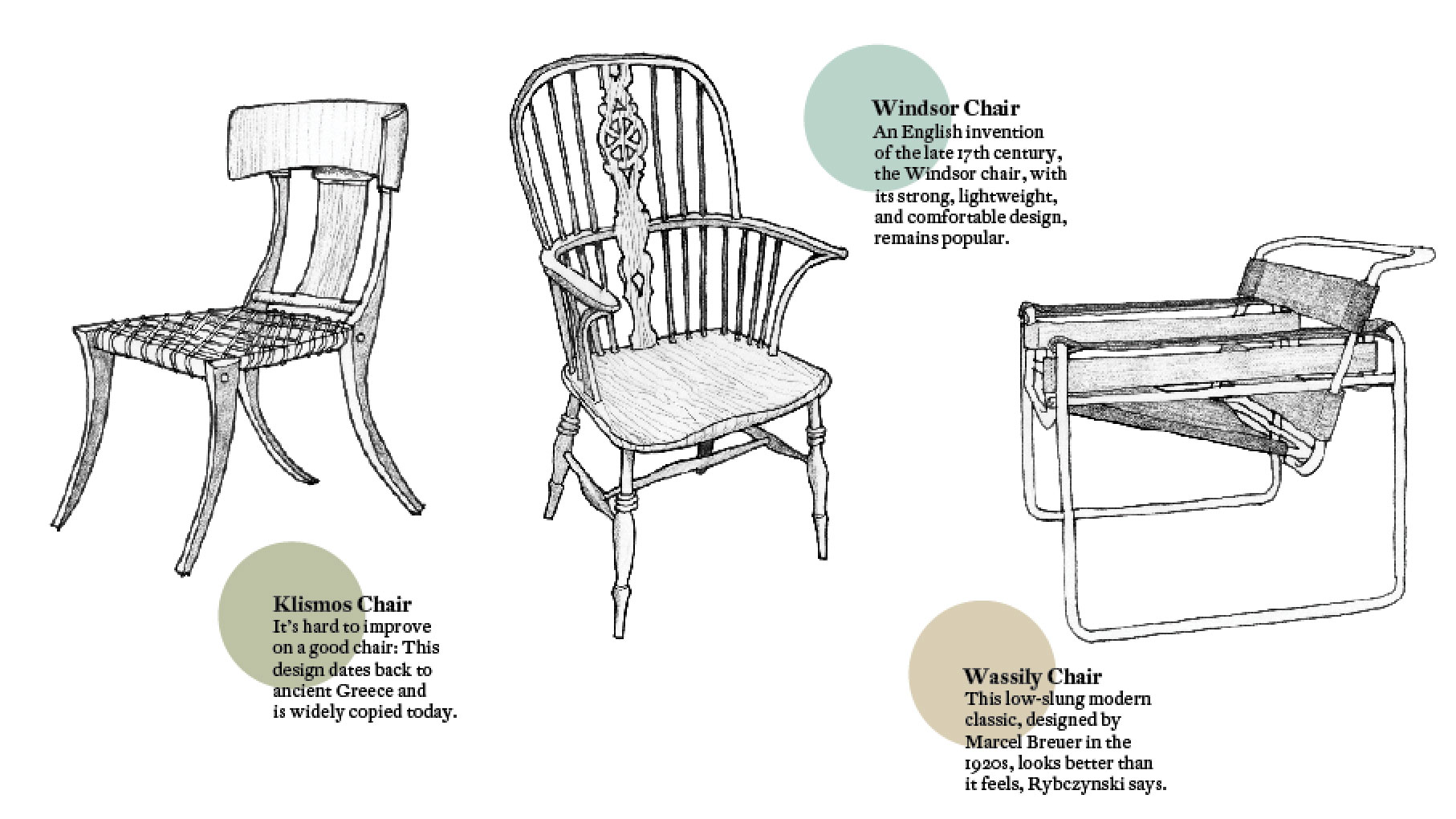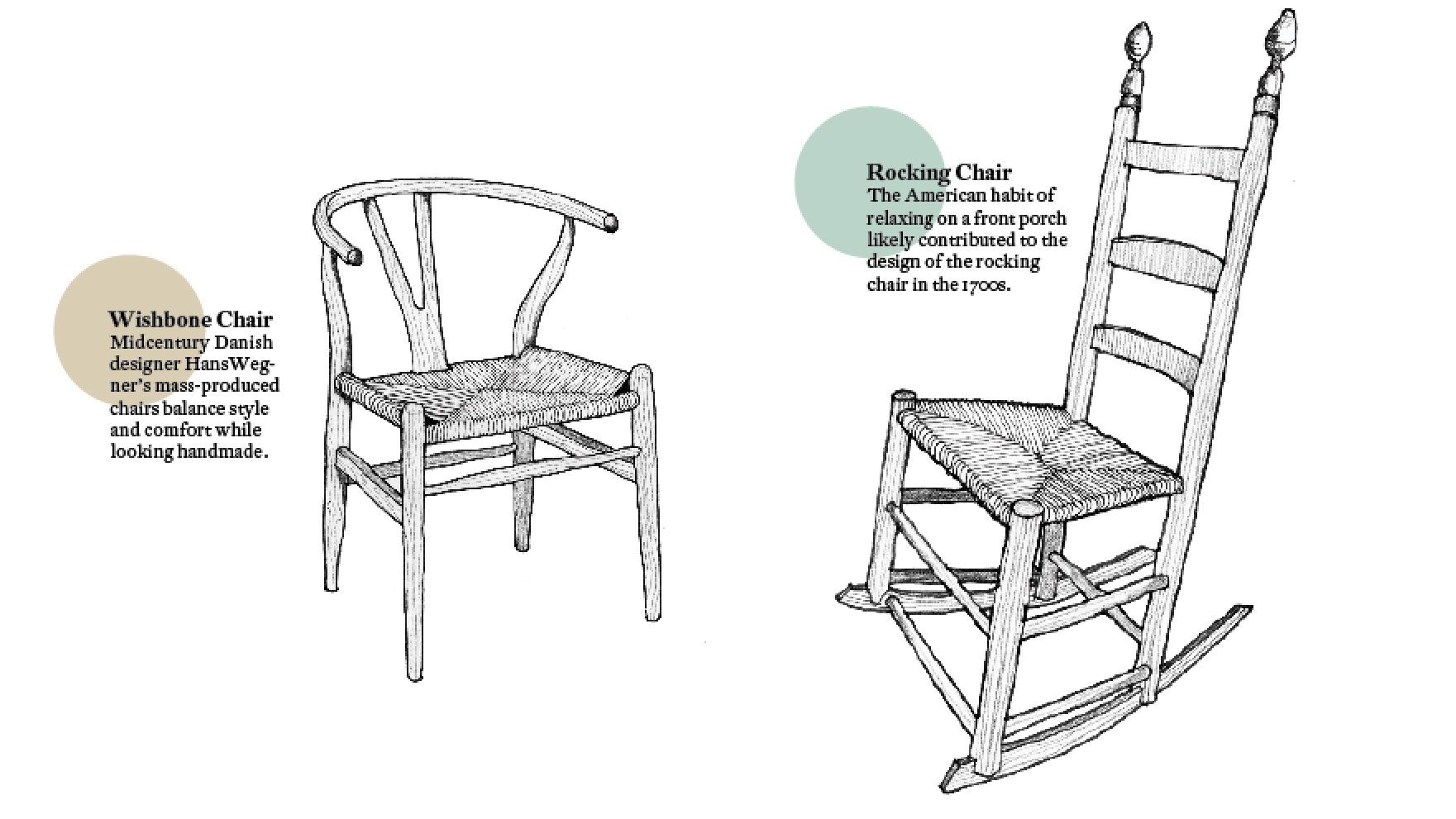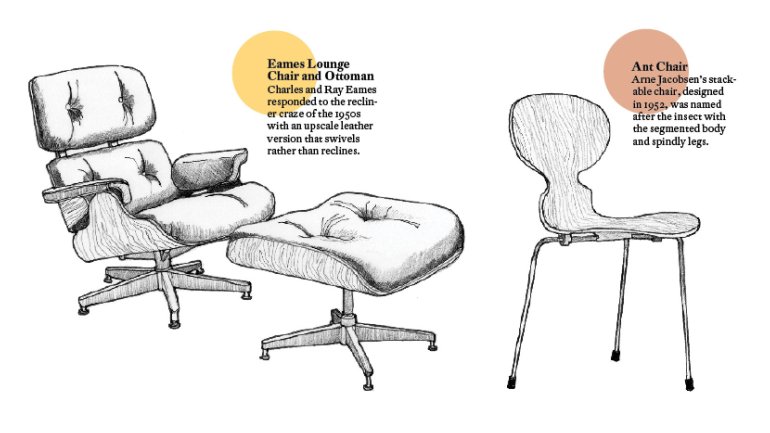Take a Seat
Take a Seat
Right now, you’re probably sitting on something. Maybe you’re nestled in a favorite reading chair below a lamp or a window, or you’re perched on a wooden stool at your kitchen counter. Perhaps you’re biding time on a generic upholstered bench at the doctor, or you’re wedged into a vinyl seat on a plane. Or maybe – lucky you – you’re reclining in a midcentury Eames lounge chair.
We may not talk about them much, but chairs, in their many forms, play a big role in our lives. And although experts say our sedentary culture isn’t doing us any favors (standing desks, anyone?), there’s no denying that we’re creatures of habit who love to sit. We simply couldn’t do without chairs.
As an architect, Witold Rybczynski understands the form of a chair in a way many of us don’t. As a professor emeritus at the University of Pennsylvania, and a writer on topics such as domestic comfort, the history of hand tools, and the impact of style and fashion on architecture, he has a rare grasp of the evolution of chairs – if not sitting – over the ages. His latest book, Now I Sit Me Down: From Klismos to Plastic Chair: A Natural History, takes a humanist approach to this often-ignored piece of furniture, connecting trends, culture, and technological innovation to provide a personal and historical survey.
He took a moment to chat about why chairs are often our most treasured pieces of furniture – and why we can stand to sit in them for only so long.
You devoted a whole book to the chair. What’s so special about this piece of furniture?
I think chairs are very personal, not just for me but for many people. There are many characters in literature who have a favorite chair or who are associated with a chair. In All in the Family, Archie Bunker’s chair was very important. And even when he wasn’t on the screen, the chair was almost like a stand-in for him, and other people weren’t allowed to sit in it. So I think chairs, of all the furniture, are the most personal.
And they often remind of us people. Why is this so?
They remind us of people because we use human terms to describe chairs. They have “arms” and “legs” and “backs” and “seats.” It’s easy, when you look at a chair, to imagine the person in it. If it’s empty, then you can almost see a person sitting in a chair, because it’s got arms to support, and it’s got a back – especially if it’s a chair you associate with someone.
There’s a long history of chairs that look like animals. And chair legs traditionally had claws at the end or paws or hoofs or things like that. There’s a very famous chair that I illustrate in the book called the Ant Chair. It’s designed by Arne Jacobsen, a Danish architect. He was designing a factory [in the early 1950s], and he had a cafeteria for the workers, and he wanted modern chairs. He couldn’t find any chairs that he liked that would fit his aesthetic, so he designed this chair, which was very famous because it’s the first chair where the seat and the back are made out one piece of molded wood. But he put very thin metal legs on it, and it’s called the Ant Chair because it actually looks like an ant. It’s got these insect-like legs and then a kind of curvy top, and so it reminded people of an insect.

Why do a number of chair models – including the Greek klismos chair – remain popular centuries after being developed?
A chair, of course, is a tool. It’s used for sitting, among other things. And actually there are many tools that last a long time. A claw hammer, for example, was invented by the Romans – who invented nails; that’s why they needed a hammer.
But if you look at Roman hammers, they’re basically the same as hammers today. You can’t really improve a hammer. And chairs are the same. Take a Windsor chair, for example: If you want to make a chair out of wood, and you want to make it light and not too expensive, that’s an excellent design, and you can’t really improve on it. And so people simply repeat it.
Also, sitting hasn’t changed. The human body hasn’t changed. So a stool that the Egyptians sat on will serve us just as well. The little folding camp stool is a very good example, because that dates back to Egyptian times.
There’s a wonderful quote from Charles Eames, who said, “[Designers] should only innovate as a last resort.” We think of innovation as a marvelous thing, but really, if you don’t need to innovate, it’s always safer not to. Why would you reinvent a hammer?
You also quote Niels Diffrient, famous for his ergonomic chair designs, who said that sitting comfortably is “a rather unsolvable problem.” Why is it so difficult to make a comfortable chair?
It’s the human body. I mean, basically the body is very well designed for walking and running and standing. Sitting is very awkward because you have to support the back, the sitting bones. If you’re sitting on something hard, you eventually get uncomfortable. If you’re sitting, pretty soon you cut off the circulation to some part of the body, and that also leads to discomfort. So it’s essentially very difficult, if not impossible, to be really comfortable over long periods of time if you’re sitting. That’s really a function of the human body, and there’s not much you can do about it.
Speaking of comfort, you write about your Wassily Chair, one of the most iconic modern chairs around. For years you yearned for one, then realized it wasn’t enjoyable to sit in once you actually got one. Now it serves as a classy clothes rack in your bedroom. Why has modern chair design often ignored comfort?
In the early 20th century, you have people like Frank Lloyd Wright or Charles Rennie Mackintosh or the Austrian designers who design chairs, but they’re not carpenters or chairmakers. And so designing the chair becomes much more theoretical than if it’s being designed by somebody who makes it or knows how to make it.
Early in the 20th century, when modern chairs appeared, it’s not just that the person designing the chair is not the same person who makes it; it’s also that the idea of design becomes separated from the chair. So you can actually talk about the design of a chair and not talk about comfort or how solid it is or how long it will last.
Previously, I don’t think people thought of design as a separate aspect of a chair. The comfort of a chair, the durability of a chair, the way it was made – these were all combined, conceptually.
It’s not necessarily a good thing when we separate design from everything else, because it’s very artificial. It’s like talking about the way a person looks rather than the way the person actually is. It favors just one aspect of a chair.

Many chair designs are closely tied to customs. For example, the rocking chair is a distinctly American design. Why is this?
Well, we invented it. The cradle, which is a kind of rocking baby bed, dates to the Middle Ages. So people knew about them, and people built cradles for hundreds of years. But it wasn’t until the 18th century in the United States that somebody combined chairs and rockers. The earliest American rocking chair is actually a nurse chair meant for women holding babies. So it was invented here, but it also became very popular here. It wasn’t just used by women holding babies.
It was used by all sorts of people, and [by the 1820s] it really became a craze, a sort of fad. It’s also connected with the porch, because sitting on the porch is an American habit. Most of the United States has really hot, humid summers, and so people build porches, and the rocking chairs somehow became a natural thing to put on a porch, because you could rock and sit there, and the rocking actually creates a little bit of a breeze. So there were a number of things like that that sort of encouraged the popularity of rocking chairs, which eventually migrated to Europe, much later.
Originally, Europeans were taken aback by the design. You quote one who called it a “wooden narcotic.”
I quote lots of Europeans who visit America and who are kind of surprised at the rocking chair, because they’ve never seen such a thing before. The chair is, in many ways, a status piece of furniture. So the idea of a chair that moves is kind of anti-status, because it doesn’t look important or serious to see a chair rocking back and forth.
You also say that, in chair design, “form does not follow function; it follows culture.” What do you mean?
I was pointing out that posture comes first, that chairs vary according to posture, and posture is not something that starts with the chair; it starts with society. People want to relax more, or they want to look more vertical, more strict. The Shakers didn’t build the kind of chairs they built because they had technical limitations. They wanted a certain kind of furniture because they wanted to sit very vertically. Shaker furniture is not meant to relax in. That’s not the kind of chairs they built, and that was very much part of their worldview.
Similarly, if you look at French furniture of, say, the 18th century, there’s all sorts of chairs to relax in because it was a very materialistic, sybaritic society that liked the idea of relaxation and reading and entertaining people. And so they developed chairs – the chaise longue is a particular one – that you could recline in and feel relaxed in, and read books. Reading became popular at that time. So the posture comes from society and culture, and then the chairs follow from that.

So the chaise longue defines the values of 18th-century France. What about contemporary culture?
I reached out to three experts to find out which chair defines our time, and they each chose the plastic monobloc chair. I think the reason is that it’s a chair that’s uniquely of our time, and there’s nothing like it preceding us. The main reason is that it’s a chair that’s made out of one piece of material. It gets rid of all the joints. And joints are always the challenge in chairs.
So that’s part of the reason, and the other one, of course, is it’s a mass-produced chair that is literally untouched by human hands. It’s entirely made in a machine. When it comes out of the machine, it’s ready to be sat on. It doesn’t have to be polished or painted or anything. And because it’s made from a cheap material, it’s an extremely inexpensive chair. I think the reason that it is such a symbol of our time is that it’s a global chair. The plastics industry exists in all countries of the world, and they’re the ones who really invented this chair.
It’s also an unusual chair because it doesn’t come from a chair designer. It really comes from a factory making plastic buckets and water containers, and they just are looking for products to make, because they have these huge machines turning out various things. So they were looking for products, and they just added the chair as one of the things they made in these factories.
I was surprised when the people I asked suggested this chair, because I hadn’t thought of it at all. I thought maybe the ergonomic task chair is the chair of our time. But I was really convinced at the end.
Do you have a favorite chair designer?
I devote a whole chapter to Hans Wegner, the Danish furniture designer. I think, if I had to pick one person, it would probably be him. Partly it’s because he was trained as a joiner. He was trained as a furniture maker, but he ends up working as a designer for mass-produced furniture. And so he has the skills as a carpenter; somebody called him the world’s best carpenter.
His chairs are made in factories, but they also manage to look like they were made by a person rather than a machine. They are beautiful designs, which are both original and very traditional.
What else did you learn while writing Now I Sit Me Down?
I quote design critic Ralph Caplan, who said, “A chair is the first thing you need when you don’t really need anything.” And I think there’s some truth in that. I’ve written a whole book about chairs, but it’s important not to make chairs more than they are. I mean, it is a tool for sitting, and the truth is, you can sit on anything.
If you get tired when you’re hiking, you can just sit on a rock or a tree stump or just on the ground. So in that sense, we shouldn’t make a chair more than it is. It’s a simple tool that’s a pleasure to sit in if it’s a good chair, and especially if it’s a favorite chair.
Talking to people since the book came out, I realize also that what makes a chair a favorite is not the design, it’s what you do in it. The chair that you read in, for instance, can be a favorite chair because that’s where you take time out of the day to relax and read a book. It wasn’t the design of Archie Bunker’s chair that made it his favorite. I think it was because that’s where he came home at the end of the day and relaxed.


